In the midst of World War II, the Swedish government adopted the AG-42 Ljungman self-loading rifle, which was chambered for their standard 6.5x55mm cartridge. It was issued to supplement squad firepower, and proved to be an accurate and reliable weapon. In 1965, it and the M96 Swedish Mausers were replaced by the AK4 rifle (an H&K G3). However, before the H&K design was adopted there was experimentation with other options, including updating the Ljungman rifles to a more modern configuration. That particular experiment too the form of the prototype FM-59 rifle:

Just 10 FM-59 prototypes were made, converted from existing AG-42(B) rifles. Bringing the old Ljungman up to date would require a 20-round box magazine in place of the original 10-round magazines and stripper clips and a change from 6.5mm to the NATO standard 7.62mm rifle cartridge. The magazine conversion was pretty simple, since the Ljungman already used a detachable box magazine. A new, larger magazine was designed to fit the action:
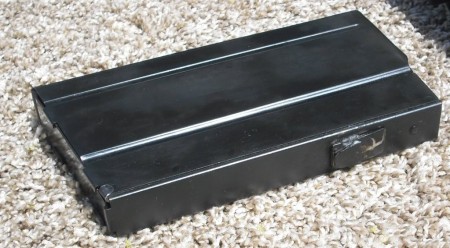
When making the conversion to 7.62mm NATO, however, it was decided to abandon the direct gas impingement system that had made the Ljungman design distinctive. In its place, a short stroke gas piston was adapted to the rifle, much like that of an SVT-40. Most sources suggest this was a necessity because of the higher pressure of 7.62mm compared to 6.5 Swedish, but this does not seem to ring true. The pressure difference is not particularly great, and the Egyptian Hakim is essentially a direct copy of the Ljungman which handles 8x57mm pressures just fine. Rather, I suspect the change in operating system was led by a belief that a short stroke piston would be more reliable.
Regardless of the rationale, the FM-59 does in fact have a narrow piston in place of the AG42’s gas tube. This piston is covered by a sheet metal front handguard, which is rather conspicuously marked “<- framåt” (which simply means “front”) at the front end.
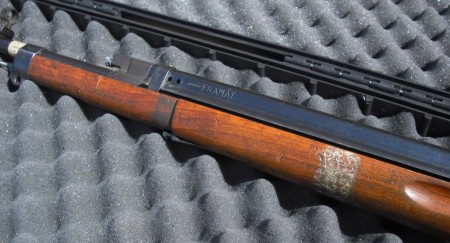
Being more modern and tactical, the FM-59 rifles were also fitted with a flash hider in place of the Ljungman’s original compensator holes in the muzzle:
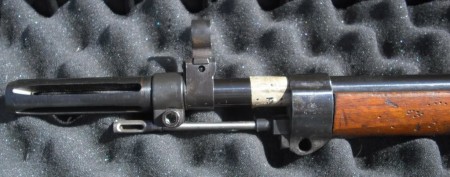
Unfortunately, I don’t have a photograph showing the piston assembly under the handguard, but I do have this shot, which shows the rear end of the piston, which extends out of the receiver to push the bolt carrier with each shot. In a standard Ljungman, this is a small cup which the bolt carrier nests onto when closed, to help retain the gas from firing. That cup has been ground off on this FM-59 (you can see where it was, around the piston end).
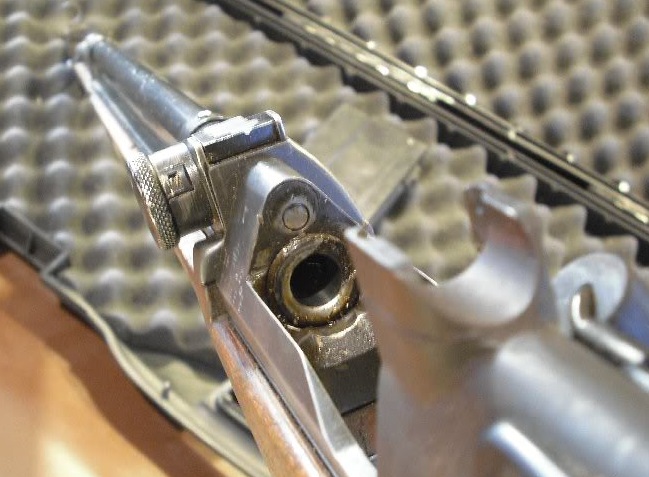
The rest of the rifle retains all the characteristics of the original AG-42(B). We don’t have any record of military trials for the FM-59, but it obviously wasn’t accepted for service. Of the ten originally converted, seven are in museum and private collection in Europe, while the other 3 were imported into the US by Sarco in 1990s.

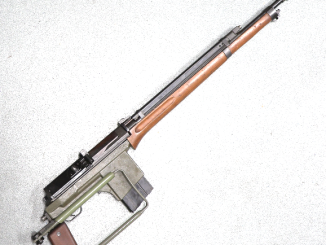

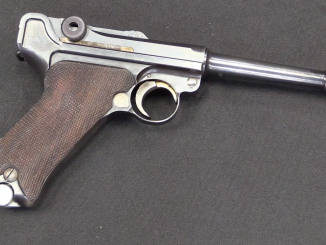
The AG-42B and Hakim direct impingement gas systems ‘wash’ the face of the shooter with surplus gas after the bolt carrier opens. Anyone shooting these rifles should wear really good shooting glasses, something not always possible during combat usage. This is probably the reason for adopting a conventional piston system in the FM-59.
So more it is strange it was adopted into AR line of rifles. True, it does not blow into your face, but gives you some extra hassle when cleaning. Swedes dumped it, French dumped it….. aren’t they wise people?
The Stoner gas system contains the gas inside the weapon and vents surplus gas through the ejection port, through holes in the RHS of the bolt carrier. Stoner probably became enamoured with this gas system because it reduces the parts count of the weapon, a major factor in manufacturing and logistics costs. A nice side effect of the Stoner gas system is superior accuricy because all the actuation forces are on the axis of the bore. The downside is susceptibility to stoppages due to fouling in the bolt/bolt carrier chamber. Diesel motor oil seems to cure this fouling when squirted into the chamber via the surplus gas exhaust holes in the bolt carrier.
The French didn’t switch away from direct impingement until 1981 when the FAMAS entered service (yes, it really did come that late), long after the AR-15/M16 series was adopted by the US military.
Very interesting. Thanks.
Interesting. Thanks! My understanding is that when the Swedish armed forces adopted the AK5 or FNC 5.56x45mm rifle, that numbers of older AK4/G3s were modified for use by the Home Guard/National Guard by having Aimpoint optic sights installed and some other modifications. For a good long while the Swedish army maintained a group of dedicated urban-warfare troops that remained equipped with AK4s in the belief that the 7.62x51mm cartridge would be more effective at penetrating available cover than the 5.56mm cartridge.
That the Swedes kept 6.5x55mm BARs, Ljungman AG42bs and Mausers in use by artillery and Home Guard/reservist use while the AK4 was the army-issue service rifle makes me wonder if this FM-59 was an exploration of “updating” the AG42 in reservist hands… Basically use the reserve stocks to remanufacture the AG42 as a 7.62x51mm rifle, even if the magazines might not interchange with the AK4/G3…? Thoughts?
so its the product of “improved carbine competion” circa 1959?
What drove the Swedes to adopt 7.62 NATO? I would have figured that they would have continued developing the 6.5 Swede; perhaps a 6.5 Kurtz?
The Swedes have always held a grudge against the Russians, and relations got fairly heated during the cold war (look up the Whiskey on the rocks incident).
Even though the Swedes were neutral they leaned heavily towards NATO knowing that NATO would likely fight the Russians to some degree if Sweden was invaded.
But this in no way meant that Sweden was a direct ally of NATO, and both Sweden and NATO did quite a bit of spying on each other, Sweden going so far as to track all US aircraft in it’s airspace including U2s and SR-71s. And the US air force supposedly calling and congratulating the Swedes 10 minutes after they got missile lock on a blackbird.
Basically it was a sort of “the enemy of my enemy is my friend” deal, but neither party trusted the other.
To this day whenever the Swedish armed forces do drills to fight pretend enemies those enemies are always Russians.
Well, Swedish iron ore and steel supplied the Third Reich arms industry… The Norwegian invasion of 1940 was mostly to protect trade in the Baltic. Swedish politicians were astute enough to recognize that Germany would lose the war by 1943, and policy shifted accordingly. Sweden trained and equipped pro-Western resistance movements in Norway and Denmark. Sweden deported a good many Estonians at the end of WWII to Soviet-occupied Estonia. Sweden tilted toward NATO because, as the Wikileaks revealed, Sweden was a krypto-Nato member, albeit officially “neutral.”
Sweden greatly aided the pro-socialist social democrats/anti-communists in Portugal after the April 1974 “Revolution of the Carnations” and also greatly supported Poland’s Solidarnosc union movement in the 1980s. On the other hand, Sweden also was not favorably disposed toward the apartheid regime in South Africa, which put them at odds with Great Britain and sometimes the US.
As far as Swedish drills directed at Russian aggressors, a look at the wars Sweden fought prior to, say, Leipzig 1813 shows that Russia has frequently been an enemy.
Yeah, switching from 6.5x55mm to 7.62x51mm really seems like a step backward. Introducing something in the area of a 6.5x40mm seems like it would’ve made for a good assault rifle round.
the name FM59 is translated as TM=Test Model. The nato round was adoptes As replacement for the 8 X 63 Machingun round, that was overpowerd, at the time the sweds adopted the FN Mag mashine gun, that was alredy chamberd for this round.
Ljungman rifle is a real sample of Direct İmpingement Gas System in which taken
gas simply strikes against to a face of rod inserted in front top of breechbolt
to make it getting backwards out of lock engagement. Since the rod face being
open at its circumference, the striked gas freely spreads everywhere including to
the shooters face.
French used the same system in their MAS49 rifle with a small change for gas
impingement location formed as a cylndrical cavity, therefore lessening the gas
reflection.
Stoner’s system, in fact, is not a direct impingement type, since taken gas expands
in a gas cell located in the breechblock carrier for the sake of joining all
reciprocating auto loader elements in line with the barrel axis to lessen the
moving mass effects creating a swing to the direction where bigger off line masses
joined during automatic firing. System’s true name should be “Inline Gas Piston”.
I have a HAkim in 8mm .I got it in a trade and should shoot it sometime I guess. The guy gave some 30 round mags that he said would work supposedly G3 Geman mags.They were too tight for another guys Hakim maybe my mag well was widened.Anyway if it ever stops raining(SWVA) I guess I will run some midlife through it.Interesting report.
The loudest rifle I have ever fired in my life… Even louder than the self-loading SVT-40 Tokarev! The Hakim 7.92x57mm is an odd big ol’ rifle.
I wonder how Egyptian end up adopting this gun AG42 ??!!
theswedish firm Bofors, were delivering water turbines for the big damm projekt, ad they were agents for Carl Gustav state arms factory,witcg had the rights for the Jungmann. One small delivery of jungmanns for Egept, was made by DISA-Madsen in Denmark. The Egyptians, also made a version in the russian 7,62 X 39 cartridge.
Need to find out how to take apart a 6.5×55 Swedish,Ljungman M42B rife magazine to clean it, w/o damaging it.
Can anyone help ?
Yes. First cock the rifle with the magazine out and then allow the bolt to travel forward. Then move the safety lever to the center of its arc and pull it out of its hole. Then you can remove the bolt cover and carrier for cleaning and you can also access the chamber and bore from the rear if you wish. Reassemble in reverse with the hammer cocked and your carrier and cover should slide right into place. Hope the helps.